EVELYN DE MORGAN: SYMBOLISM, FEMINISM AND MYSTICISM
LYNDA HARRIS
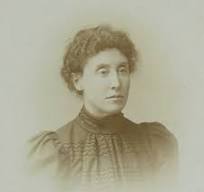
(The photograph of Evelyn de Morgan is reproduced by kind permission of The Watts Gallery, Compton, Surrey).
Lynda Harris has degrees in the history of art from three universities. She has taught extra-mural classes in art and symbolism for London University, and at various venues in and around London. Her book, ‘The Secret Heresy of Hieronymus Bosch’ was published in 1995.
EVELYN DE MORGAN
Symbolism, Feminism and Mysticism
BACKGROUND AND BIOGRAPHY
Evelyn Pickering De Morgan, who lived between 1855 and 1919, can be described as either a late Pre-Raphaelite or an English Symbolist. What stands out in her works and makes them exceptional is their spiritual and idealistic subject matter. She painted in a technically perfect and rather academic style, which grew softer and more luminous during her later years. Her most mystical paintings were executed during the last fifteen years of her life, and were therefore painted in the twentieth rather than the nineteenth century. They were continuations of an evolution begun earlier, and were still in the spirit of the last decades of the nineteenth century. By the beginning of the twentieth, tastes had begun to change and spirituality and symbolism in art were going out of fashion.
Evelyn was the eldest child in a family of two boys and two girls. Her younger sister, Wilhelmina Pickering Stirling, later wrote a number of books about her family. One of these, published in 1922, was a biography of Evelyn and her husband, the potter William De Morgan. Wilhelmina gave this work the undeserved and rather belittling title William De Morgan and his Wife. The book is an important source which reveals many useful facts about both artists, but it is not always entirely reliable. In addition to a number of omissions (Evelyn’s friendships, for example), it contains some incorrect dates, which are contradicted by other, more reliable sources.
Evelyn was ten years older than Wilhelmina, and the latter’s memories are, if nothing else, an accurate record of how Evelyn appeared to her. Wilhelmina describes her older sister as having a strong and intense personality, which caused her some childhood distress. In a notebook located in the De Morgan Centre collection Wilhelmina remembers being called ‘Baby’, and says that Evelyn was not always very nice to her. And in William De Morgan and his Wife, she records having nightmares because of the gruesome stories of ghouls and other horrors that Evelyn told her at bedtime.1 But despite these memories, Wilhelmina attempts to give a rounded description of Evelyn, and appears to be objective enough. She tells us that:
‘Her expression was full of life and intelligence, though always marked by a noticeable discontent…her whole personality, from childhood to age, conveyed an impression of virility, of restlessness, and of a mind eager to absorb and to achieve, combined with a temperament highly strung and perhaps abnormally sensitive to suffering and to joy.’2
In her various books Wilhelmina also discusses her mother’s aristocratic relatives, including Coke of Norfolk and the Spencer Stanhope family. The Pickering family lived in London. The father, a successful barrister, was elevated to the rank of QC. The mother, though well educated and an intellectual, followed the conventions of the time and did not have a profession. The two boys went to school, while the two sisters were educated at home. Nevertheless, the girls were given as good an education as their brothers. Both, taught at home by their mother and by tutors rather than governesses, made use of their abilities in adult life.3
Evelyn, always independent and determined, never tried to develop the unassertiveness and so-called ‘soft subservience’ which were expected of women from her upper class background. She refused to be presented at court, and would have nothing to do with the social events of the marriage market. She began painting at an early age, committed to becoming a professional, rather than just the charming amateur that her mother (who remarked ‘I want a daughter – not an artist!’) would have liked.4 In 1873, at the age of seventeen, she insisted, against both her parents’ wishes, on going to the Slade School of Art. One of the first women to attend, she was supported in her ambitions by her uncle, the Pre-Raphaelite painter Roddam Spencer Stanhope. Her talent was vindicated when she won numerous scholarships and prizes, and, from 1877, exhibited at the Grosvenor and other galleries. Her style was influenced by Edward Burne-Jones and her uncle Roddam, as well as by various fifteenth century Florentine painters, especially Botticelli.
According to her sister, Evelyn’s dedication led her to paint ‘all day long, and nearly every day for nearly forty years’.5 This single-minded application (even if somewhat exaggerated by Wilhelmina) was very unusual for women of her period, and resulted in a larger than average output of works. But it may also have been something of a personal sacrifice. According to her sister, the years before her marriage were filled not only with aspiration and achievement, but also with hardship, poverty, loneliness and work.6 Nevertheless, though Evelyn was certainly dedicated to her work, she is also known to have had many female friends. These included painters and idealists such as Emily Ford, and members of the Pre-Raphaelite circle such as Margaret, the daughter of Edward Burne-Jones.
In 1885, when she had reached thirty without apparently showing any interest in men, Evelyn suddenly surprised her family (her mother thought at first that she was playing one of her practical jokes), by announcing her engagement to the potter, William Frend De Morgan. William, the son of the successful mathematician Augustus De Morgan and the well known Spiritualist author Sophia De Morgan, was eighteen years older than Evelyn. He impressed a Miss Robinson, a family friend as looking like ‘an old bachelor’ in contrast to Evelyn, who was ‘such a bright, harum-scarum thing’.7 The marriage took place two years later, and, as it turned out, the couple got on so well that their relationship was later described by Georgie Burne-Jones (whose own relationship with her husband Edward had not been trouble-free) as ‘one of the blessed marriages’.8 Evelyn, though a serious person, had a quirky sense of humour which she shared with William. He, in particular, was constantly telling jokes and making puns. His letters to his friends Edward Burne-Jones and Roddam Spencer Stanhope are full of them, and though they do not always seem funny today, they provided a great deal of camaraderie and laughter.
Evelyn and William had no children, and there are no records which indicate their feelings on this subject. We do know, however, that they both worked intensively at what interested them the most. Evelyn was committed to her oil paintings, while William spent his time on pottery designs, glazes and other technical inventions. This continued until 1907 when, in his sixties, he wound up his pottery business (which had been successful artistically, but not economically), and became a prolific and popular novelist. Until 1914, the couple spent most of their winters in Florence. When in England they lived in a rambling house called The Vale, which was located in what was then a rural enclave off the King’s Road in Chelsea. In 1910, when their Chelsea home was torn down to make way for development, they moved to nearby Old Church St. Their large and attractive house (number 127) still stands there, and the many-paned windows which must have lit Evelyn’s art studio can still be seen.
Evelyn’s connections with Florence went back to 1876, when she first stayed with her uncle Roddam in his villa in Bellosguardo. This extremely beautiful suburb of Florence, which is still unchanged today, is in walking distance of the city centre. The Villa Nuti, palatially large, and surrounded by gardens and olive groves, is currently being restored by its private owner. Roddam lived in it from 1873 until his death in 1908, and Evelyn was a regular visitor there. She and William continued to spend their weekends at the villa, even after they had rented their own flat in Florence’s Via Milton in 1890.
But the De Morgans’ life was not entirely untroubled. William was not a good businessman, and his pottery works at Sands End in Fulham continually made a loss. Evelyn not infrequently used her inherited money to help out with his pottery debts. She held firmly to the point of view that artistic and spiritual values were more important than material ones, but at the same time appears to have felt uncomfortable about the situation. In 1900 William mentions her feelings in a letter to his English assistant, in which he says:
‘The reason I am so very anxious…is that I find finances here are slipping into the old way of my borrowing of my wife to pay Torquato and Co., greatly to her perturbation….’9
Like many of his contemporaries, William also had health worries. Four of his adult siblings had tragically died of T.B., and when William developed a painful back, his doctors, worried that it might be caused by tuberculosis of the spine, advised him to spend the winter months out of England. This advice instigated the couple’s custom of regularly spending their winters in Florence. Though the pain (which turned out to have other, less serious causes) continued, William lived until 1917, when he died in London of the Spanish flu. Evelyn, though younger, survived him by less than two years, dying in 1918.
PAINTINGS AND EXHIBITIONS
Evelyn exhibited her paintings about once a year at various venues in England, including the Grosvenor Gallery. Though some of the works which sold are now on display in English museums, the majority were bought up after Evelyn’s death by her sister Wilhelmina, and kept in her large residence, Old Battersea House. Wilhelmina’s collection also included artworks by William De Morgan and Roddam Spencer Stanhope, as well as various family letters and diaries. A number of the papers are now missing, and it appears that she destroyed them after writing her family biographies.
Wilhelmina, who died in 1965, bequeathed her collection of paintings, pottery and family papers to the De Morgan Foundation Charity. The collection remained at Old Battersea House until it was partially dismantled in 2002. Some works were sold, but most were moved to the new De Morgan Centre in London SW18. Evelyn’s works, along with many examples of William’s pottery and the remaining papers, were accessible there until the Centre closed in 2009. The Centre is due to re-open on a temporary basis in the same location in the Autumn of 2011.
Though displayed annually, Evelyn’s paintings did not attract a great deal of notice from the critics during her lifetime. Did this, along with her comparatively low rate of sales, bother her? Though there are no extant records of her feelings on this subject, it is rare for any artist to be entirely indifferent to public opinion. As will be seen below, there are certain hints that she did need reassurance about her work, and experienced some suffering when it was not appreciated. Nevertheless, she never lost her enthusiasm for her art. She continued to paint regularly until the end of her life, whatever the reception of her works, and whether she was in England or in Florence.
SPIRITUIALISM, AND MYSTICAL WRITINGS
Until her marriage to William De Morgan, Evelyn’s subjects were often mythological, but they show no signs of esotericism or mysticism. A noticeable change in subject matter and meaning can be seen from about 1887, two years after she met William, and the year she married him.
The main catalyst for the change in Evelyn’s ideas and iconography was probably her mother-in-law, Sophia De Morgan. Sophia was the author of the influential book From Matter to Spirit, which had been published in 1863. Sophia was a committed Spiritualist and an admirer of Swedenborg, though she qualified this by saying that she ‘read Swedenborg with some comprehension, though not with a literal belief….’ Sophia also took a continuing interest in esoteric ideas. Jane Morris (the wife of William Morris) gives an interesting description of Sophia at the age of eighty three, when she paid a visit Jane in 1890. Clearly, Sophia’s interests and enthusiasms were as strong as ever. As Jane describes it, she:
‘….talks incessantly when not reading and has the wildest theories about various subjects – she is now deep in Kings Gnostics, no book is too long or too deep for her to attack – with all this she is the sweetest, kindest and most sincere of women….’ 10
But wide though her interests were, Sophia’s clearest influences on Evelyn seem to have been her Spiritualism and her esoteric Platonic and Neo-Platonic ideas. The latter views are likely to have been derived from Thomas Taylor the Platonist, a late eighteenth/early nineteenth century writer and translator, who also had a great effect on the ideas of people such as Blake and Coleridge. Sophia reports in her autobiography that Taylor visited her father William Frend when she was a child, when he discussed the profound symbolism which, ‘setting forth psychical and even religious truth, underlies the myths of gods and goddesses’.11
Sophia presumably introduced Taylor’s Platonic – almost Gnostic – view of the physical world to her daughter-in-law. Though there is no record that Evelyn herself appeared gloomy or depressed in everyday life, her works now began to express ideas about the darkness of the physical world, in contrast to the brightness of the spiritual one. This point of view is reflected in the paintings that Evelyn produced from this period onwards. She never changed her negative view of the realm of matter, which, during the First World War became if anything more extreme. This was exemplified by her painting S. O. S. (1916), which depicts a soul, embattled by numerous demonic creatures, praying for help from heavenly realms.
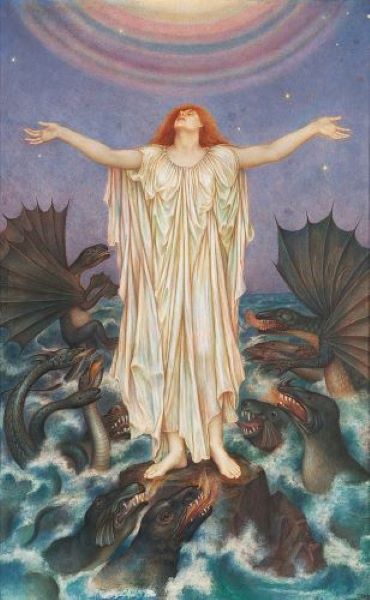
Evelyn de Morgan S.O.S (1914-1916) The De Morgan Collection
Nevertheless, from about 1905, some of her works reveal a more joyous sort of mysticism, emphasizing the brightness and rapture of the spiritual side of life. According to Wilhelmina, she ‘withdrew more and more from the world’ as time passed, ‘living in that dream-world of her own creation’12
Though Sophia and Augustus De Morgan were both members of the Society for Psychical Research, Augustus appears to have been less carried away by the subject than his wife.13 Following the example of his academic father, William seems to have combined a firm belief in survival with an open-minded, though somewhat sceptical approach to Spiritualism. Although he does not appear to have been attracted by Taylor’s esotericism or ideas of reincarnation, his conviction of the existence of an afterlife was solid. This is illustrated by his statement in a letter he wrote to May Morris in 1914, after the death of her mother Jane, in which he said ‘…my own belief is fixed, that this life is an instalment of a larger and longer one’. He adds that this belief is based partly on some ‘apparent communication with folk on the other side’, as well as the lifelong faith of his father Augustus, who was ‘the strongest consecutive reasoner I ever knew’. He particularly recommends his father’s introduction to Sophia’s book From Matter to Spirit.14
There were also occasions when William, never extreme in his beliefs, took an irreverent attitude towards the Spiritualist movement. This is shown by his reaction to an experience of Sophia’s. She announced, on returning from a walk, that ‘I have been in Battersea Park, and had a terrible shock – I came face to face with William’s Wraith!’ His response ‘Just one more of Ma’s bogies’ reveals his practical point of view.15 His down-to-earth side can also be seen in his interest in technical inventions, not only in his pottery, but also in engineering designs for objects such as flying machines.
Though William kept his feet on the ground, and does not seem to have been as much of a mystic as his wife, his undoubted interest in the paranormal led him to join Evelyn in an experiment in automatic writing. This must be what he was referring to when he mentioned his ‘apparent communication with folk on the other side’. Evelyn and William began this experiment soon after their marriage. The dates of the individual scripts are not given, but apparently they were received over many years. The couple published some of the scripts anonymously in 1909, entitling the book The Result of an Experiment. Their connection with the book was later revealed by Evelyn’s sister Wilhelmina, who also tells us that William had some psychic abilities.16
In the introduction to the book Evelyn and William say that they devoted a short, quiet and private time to the scripts every evening, and describe their writing methods as follows:
One person holds a pencil as though writing, and the second places his or her hand on the wrist of the writing-hand of the first. The point of the pencil of course rests on a blank sheet of paper. Under these circumstances the hands usually move after a while, each operator believing in most cases that his or her hand is being pushed by the other.17
The automatically written scripts purport to come from a number of spirits at various levels of development. We are told that the less evolved souls, which tell their stories and express their views of life, death and religion, have been brought along by those at a higher level of evolution in order to help us to learn. Some of the messages are also said to come from spirits who had been known to the couple. As with most of the communicators, their names are not revealed in the book. Only a few historical figures, such as Fra Angelico, are mentioned by name.
Despite their supposedly mixed sources, the messages in the scripts are consistent overall, with only slight variations. Their point of view is very much in accord with Thomas Taylor’s writings on the Classics and the ancient mysteries. They express the same vision of the earth as a land of shadows, and also see the soul as imprisoned in the physical body. One, for example, describes souls living in the world as the ‘bound prisoners of the mire’.18 Another communicator tells them ‘Once I was on earth, fettered in the prison of the body’.19 In another quotation, the communicator says ‘Time is not and death is not; the fret of Earth is not a reality; it is a shadow and not a substance; grief is rebellion…..’20
This last point refers to the idea that the suffering experienced on earth should be accepted as a means of evolution. This view is stressed in a good number of the scripts. One typical example states ‘You are here to work, not to grieve’.21 In another script, the Renaissance painter Fra Angelico is used as an example of someone who had too happy and successful a life. He is described as still inhabiting a level of the after-world which, though bright enough, is not very high. According to one of the spirits, it is his contentment which ‘bars his upward flight’, and his resulting progress is slow.22
The scripts also say that, though most souls will eventually experience spiritual evolution in the next world, some are irredeemable. These unfortunates, who continue to love the darkness, will gradually be absorbed into it until they disappear. Such dark souls are referred to as ‘devils’, and the brighter, more developed ones are called ‘angels’. Many of the spirits which communicate are between these two extremes, however. These are the earthbound souls, which, though not evil, are lost and have not yet found their way to the light. All of these terms for souls are well known from the writings of Swedenborg, and, as we have seen, William and Evelyn were both well acquainted with Swedenborg through William’s mother Sophia. It is therefore a good guess that these parts of the scripts originated in the subconscious minds of the couple. This would apply especially to Evelyn, as she was the less sceptical of the two.
How many other parts of the scripts show an influence of the minds of the De Morgans? Another example which can be pinpointed is a frequently repeated condemnation of religious dogma. We know that this negative attitude towards established religion was strongly held by both sides of William’s family, and it seems very likely that his views on it affected the scripts. There is also a possibility that Evelyn’s unexpressed feelings about the lack of acclaim for her paintings might have had an influence on what was said about Fra Angelico.
Are there any signs of independent information which could not have been available to the De Morgans, and must have come from elsewhere? None are found in the vast majority of the scripts (at least as far as we can tell, without more names, and a more intimate knowledge of the individuals concerned). There is one particular example which just might be evidential, however. This seems to predict the horrors of the coming World Wars – events which could not have been foreseen by anyone living before 1914. According to this prediction, a ‘great discovery’ is coming:
‘….the veil is to be removed, and Hell on this side touch earth. The only hope will be in art and beauty…moral darkness will cover the earth, and many people very good under the present system will have their faith crushed by the revealed powers of Spirit Hells.’23
Is this a chilling vision of the hellish trenches of World War I, and/or the unimaginable evils of the Nazi death camps? Both can be described as hell touching earth. Any example of evidence can be argued with, but this one is at least interesting, and worth taking into consideration.
But even if some of the writings did have connections with genuine spirits as Evelyn and William believed, most of their content is undoubtedly interrelated with the personal thoughts and convictions of the two writers. As said above, the overall mystical and Platonic aspects of the scripts would have resonated with Evelyn’s views. These, though not recorded in writing, are expressed through her art. From 1887 onwards, she produced a large number of pictures which, like the scripts, criticized materialism. Many of her works also express her visions of the trapped soul and its evolution after death. Some do this explicitly, and others through symbols. Though we will only have space to look at a few of them, these examples should give an idea of her subject matter.
EVELYN’S WORKS: EXAMPLES AND INTERPRETATIONS (All paintings referred to (but one) are within the The De Morgan Collection).
Entrapment in the world of matter: The Soul’s Prison House (c.1889)
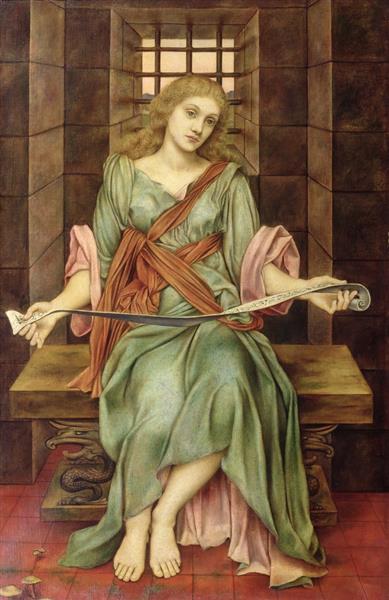
Evelyn de Morgan ‘The Soul’s Prison House’ (1888). The De Morgan Collection
This painting depicts a female figure sitting on a stone bench in a small cell. Behind her, a recessed grated window allows some light from the outer landscape to enter the room. She holds an open scroll, and stares pensively into space. The writing on the scroll is illegible, but, in 1889, Evelyn exhibited a study for this work together with the text ‘illuminate, oh illuminate my blind soul / Which sitteth in darkness and the Shadow of Death.’24 The painting is also very close to the automatic script mentioned above, where the communicator says ‘Once I was on earth, fettered in the prison of the body’. The bench on which the figure sits is reminiscent of a stone sarcophagus, used for burials. It is carved with dragons, creatures which were frequently depicted by Evelyn as symbols of the material world. These images emphasise the idea of a soul trapped in the realm of darkness and spiritual death.
Spirituality and joy: Evening Star over the Sea (1905-10)
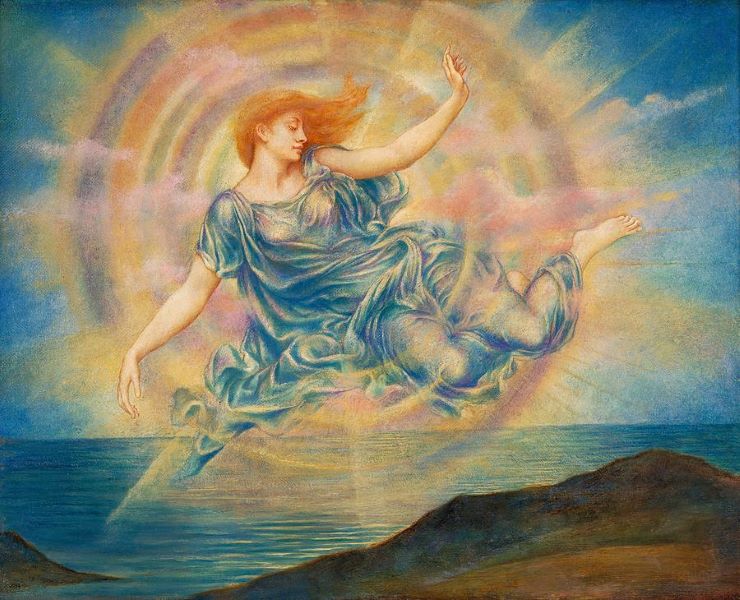
Evelyn de Morgan ‘Evening Star Over the Sea’ (1910-1914) The De Morgan Collection
This painting, executed about twenty years after The Soul’s Prison House, is a good example of one of Evelyn’s later, more joyous mystical works. It personifies the evening star as a woman draped in diaphanous and iridescent materials. She is surrounded by a halo or aura, made up of bright, multicoloured rings. These concentric circles are reminiscent of the heavenly spheres, and indicate that the figure has emanated from higher levels. Streams of light radiate from all sides of the aura, and, as the star floats low over the earth, some of the rays penetrate into the sea and the rocky shoreline. The shape of this star, with its surrounding aura, has also been compared to a compass by Elise Lawton Smith.25
The evening star, as depicted here, is different from Edward Burne-Jones’s Vesper, or the Evening Star. Edward’s personification is ethereal and otherworldly, but it does not have any apparent esoteric symbolism. Evelyn’s star, in contrast, seems to represent some sort of spiritual force which connects with the material world through its penetrating rays. And if Smith’s interpretation is correct, the star, as she says, would also be a guide. Its function would be to help find a way through the darkness, as it is identified as the evening, rather than the morning star.
But what, precisely, is this guide meant to represent, and who does it help? Most likely it is an image of what is known in the Spiritualist tradition as the spirit or higher self. In other traditions, such as Theosophy, it is referred to as the ego or the oversoul. It is the permanent and spiritual part of the psyche, whose light guides the soul during its journey through the darkness of the material world. The soul, which is involved with matter and the body during its sojourn on earth, is connected to it, even if an individual is unaware that this is the case. The spirit is able to exert a positive guiding influence on those who pay attention to its promptings. Evelyn, who was well versed in the paranormal, would have been aware of all this, and seems to be representing it here.
Evolution in the next world: The Kingdom of Heaven Suffereth Violence and the Violent Take It by Force (1905-10)
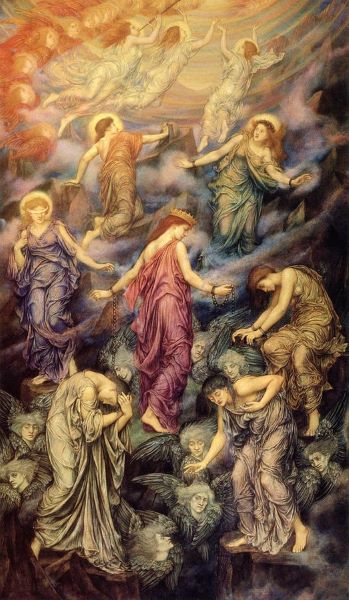
Evelyn de Morgan ‘The Kingdom of Heaven Suffereth Violence and the Violent Take it by Force’. The De Morgan Collection.
This is another late work, whose apparently inappropriate title is taken from Matthew 11:12. It quotes the words of Jesus, who is speaking of the period since the coming of John the Baptist. The quotation has been interpreted in various ways. According to some, the Kingdom of Heaven is meant to be on earth. Others understand it as referring to the next world.
In Evelyn’s depiction, the scene is clearly set in the after-world, where souls are evolving and ascending to higher levels. As in the vast majority of Evelyn’s paintings, these souls are female. And there is also no sign of any of them taking heaven by force – instead, they reach it through their own spiritual development. According to Patricia Yates, Evelyn’s less violent presentation of the scene might have been influenced by Dante’s version of the same concept.26 This is found in Canto XX of the Paradiso, verses 99-138, where the poet meets a number of pre-Christian souls in the sphere of Jupiter. These souls, who lived before the era of baptism, have nevertheless been given permission to enter heaven because of their faith and hope. One of them has even been able to return to the flesh for a short period, in order to change and become worthy of heaven.
Though Evelyn’s painting is crowded with figures at various levels of spiritual evolution, not all of them are in the process of entering heaven. One group of winged figures in the lowest section hovers amid murky clouds. The predominant colours in this part of the scene are grey and slate blue, and the figures participate in the colouring. Perhaps surprisingly, these floating figures can be identified as cherubim. Like the latter (as depicted in art, based on descriptions in the Old Testament), they are blue, with four wings and a head, but no bodies.27 In Evelyn’s very individual version, however, they are represented as troubled and depressed. They are crowded together in the darkness. None look up towards the light.
Though Evelyn depicts these unhappy figures as fallen angels, reminiscent of the ones which descended to earth with Lucifer and became his demons, they are surely images of the lost and confused ‘earthbound’ souls which frequently speak through the De Morgans’ automatic writing scripts. These earthbound souls are often described as grey, and all of Evelyn’s cherubim are depicted as blue-grey. Because there is no sign that they prefer to be in the darkness, however, they are unlikely to be the hopelessly fallen souls referred to as ‘devils’ by Swedenborg. They do not look evil, but appear to be weary, unhappy, and trapped in the realm of darkness. Unlike the ‘devils’ (which are not depicted in this painting), most will eventually manage to see the light.
Scattered among these suffering ‘fallen angels’ are three female souls, which have complete bodies and no wings. All wear draperies of various shades of grey, and all look downwards towards the earth. One sits despondently, while another leans over the abyss with her hand on her chest in a gesture of dismay. The third stands in a despairing position, cradling her bent head in her hands. What is the future of these three souls? Are they destined to rise, to join the ‘fallen angels’, or to return to the earth for another life? More will be said of them, later, in connection with the question of reincarnation.
The lower half of the painting is divided from the upper levels by a swathe of clouds. An upright figure, which contrasts with the three bent and despairing souls, is in the process of crossing the barrier. She wears a golden crown and a dark pink robe, and the broken chains which hang from her wrists represent her newly achieved detachment from earthly ties. Another soul, located on her left, stands part in and part out of the realm of shadows. This one, which wears a dark blue robe and a blindfold, has a halo. Perhaps she is a soul which, though spiritually advanced, is not yet accustomed to the realm of light. Above her, two other haloed souls at a more developed stage of evolution, and wrapped in lighter coloured draperies, continue to move upwards.
Finally, at the very top of the picture, three more souls with haloes and diaphanous white robes fly freely up through the concentric layers of the heavens. They are accompanied, during their ascent towards the realms of light, by a long, curving row of haloed angels with red wings and no bodies. These are seraphim, which are traditionally described as red. Unlike the fallen cherubim at the bottom of the scene, they all look upwards towards the light. Their contrasting position at the high end of the spiritual spectrum indicates that they represent the ‘angels’, or evolved souls, found in the writings of Swedenborg and the De Morgans’ automatic scripts.
An easy and spiritual transition: The Passing of the Soul at Death (1917-18)
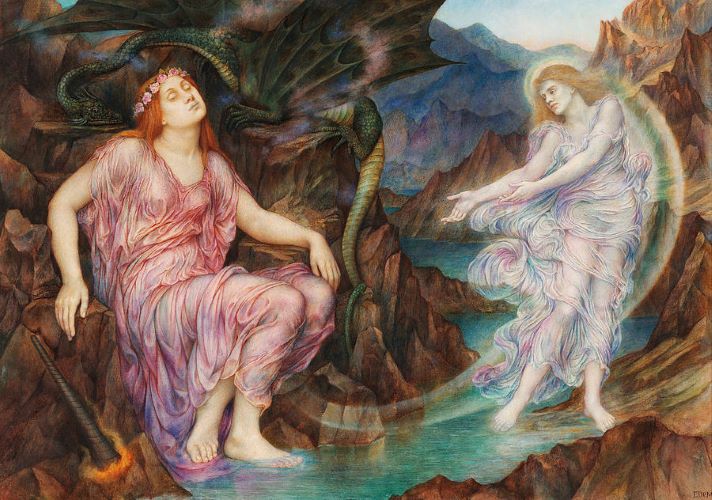
Evelyn de Morgan ‘The Passing of the Soul at Death’ (1919) The De Morgan Collection.
This work was executed soon after the time of William’s death, a year or two before Evelyn herself died. It depicts two female figures in a barren, mountainous landscape. One, slim and iridescent, stands on the right side of the scene, holding her arms out. This figure, which represents the soul, appears to be calling to the dying body on the left side of the picture. The comparatively large and heavy body sits slumped and limp, with raised face, and closed eyes. She seems to be visualizing her soul, as her consciousness moves fully into it. The two figures are still attached to each other by a stream of light, which wraps itself around the soul, forming a kind of halo.
The material world in which the body sits is dark, rocky, and presided over by a large, reptilian dragon. The landscape on the right, behind the newly emerged soul, is also rocky, but it is lit by dawn sunshine. The two sides are divided by a narrow river of iridescent blue, which winds back between the rocks to a range of blue and purple mountains. This shining river of death is depicted as shallow, and easy to cross. This particular soul will pass easily into the realms of light.
The clothes of the dying woman are dark pink shading to blue, and a crown of roses is placed on her head. A partially extinguished torch (physical life?) falls from her hand. Her crown could symbolize the pleasures of the world which will now be left behind, but, much more likely, it is a sign that she has led a spiritually successful life. Though the dying figure is female, she may possibly be a subtle reference to the recently deceased William. But whether or not this is the case, the painting undoubtedly reflects Evelyn’s feelings about the death of someone whose life had been lived well, with a high level of achievement, character and spirituality.
The ideas behind The Passing of the Soul at Death are very much in accord with those expressed in The Kingdom of Heaven Suffereth Violence. The difference is that the less crowded later work depicts the post-mortem fate of just one advanced soul. Evelyn’s earlier and more complex scene, in contrast, contains a large number of souls, at various levels of evolution, and with various destinies.
Evelyn and the question of reincarnation: The Cadence of Autumn, (1905)
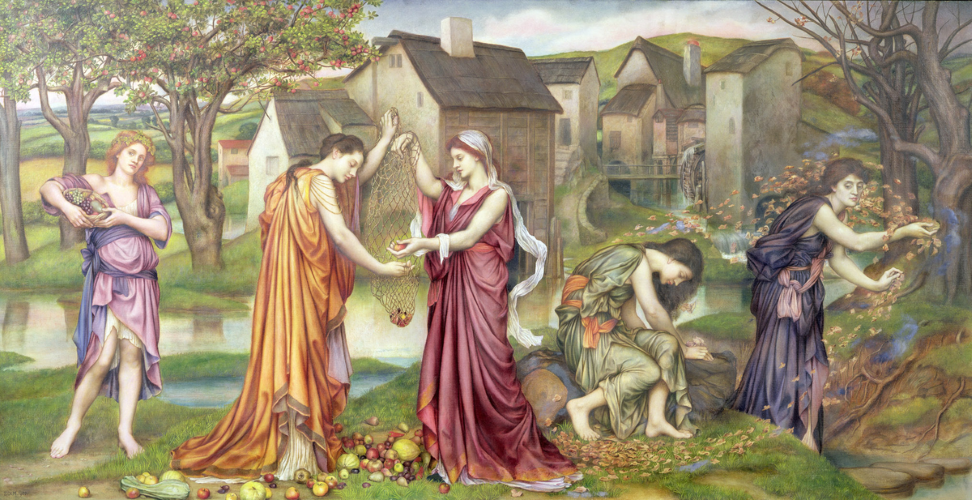
Evelyn de Morgan ‘The Cadence of Autumn’ 1905. The De Morgan Collection.
None of Evelyn’s relevant letters or diaries survive, and, during her lifetime, the authorship of The Result of an Experiment was still a secret. But, though there is no record of Evelyn saying anything about her spiritual beliefs, her paintings reveal her ideas openly. These include what are surely clear references to reincarnation. In The Kingdom of Heaven Suffereth Violence, for example, the representation of the scene might be influenced by Dante’s Paradiso, Canto XX (see above). This Canto mentions a soul which returned to the physical body in order to progress spiritually. In Evelyn’s painting the three bent and despairing souls which look downwards towards the earth appear to illustrate this aspect of Dante’s story. Their distress hints strongly at a future return to life in the world of matter.
The poses of the three troubled souls, though not exact copies, are clearly influenced by the figures moving towards the River Lethe in Roddam Spencer Stanhope’s painting The Waters of Lethe by the Plains of Elysium. According to Virgil’s Aeneid, the source of Stanhope’s scene, these figures would represent unhappy souls moving towards the River Lethe, in preparation for another incarnation.
Evelyn’s The Cadence of Autumn, which again shows an influence of Stanhope’s Waters of Lethe, is one of her most interesting depictions of the contrast between salvation and a return to earth. Though Evelyn’s home studies had given her an unusually good grounding in the Classics, this particular work, unlike Stanhope’s painting, contains an eclectic set of symbols. Following the tradition of medieval and Renaissance Last Judgments, the left half of The Cadence of Autumn represents the side of salvation and the right half depicts the side of hell. But here, as in the Gnostic and Neoplatonic traditions, damnation is visualized as rebirth on earth. This view of earth as a kind of hell is fully in accord with the point of view that Evelyn expresses in her Spiritualist paintings, and corresponds with the messages given in The Result of an Experiment.
In The Cadence of Autumn, one of the symbols of the continuing round of birth and death on earth could be the mill with a turning wheel in the right background. The figures in this work are all in the foreground, and none bathe in the river, as in Roddam Spencer Stanhope’s Waters of Lethe. Nevertheless, the two women on the right are placed in front of the turbulent waters which have been disturbed by the turning wheel. They are also surrounded by a whirling circle of autumn leaves, as they move toward the right edge of the picture. The leaves are surely another image of the eternal round of birth and death, and the figures’ bent and suffering positions are again reminiscent of Roddam’s line of distressed men and women heading towards Lethe and rebirth on earth. Like Evelyn’s three unhappy souls in The Kingdom of Heaven Suffereth Violence, they are going to a place of suffering in order to progress spiritually.
The trees on the right side of The Cadence of Autumn, with their barren, leafless branches, contrast with the abundant leaves and fruits of the trees on the left. This contrast is another medieval and Renaissance symbol of salvation versus damnation, and its significance is emphasized by the figures in the left foreground of the picture. Here, two women stand with raised arms, holding a net with fruit in it. Various other autumn fruits and gourds are piled around their feet, and a youth on their left carries a basket of grapes. These images of an abundant harvest tell us that the figures on the left have led a fruitful life. This image of fruit is found in one of the automatic scripts, which states ‘You are in a land of shadows and your days are spent in probation, but on your attitude of mind depends the fruit you reap’.28
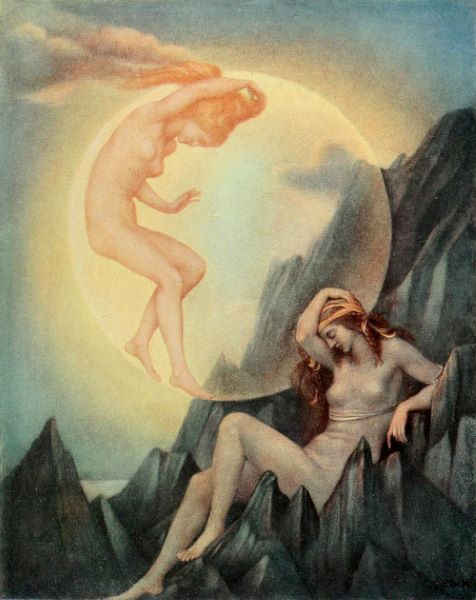
Evelyn de Morgan ‘The Sleeping Earth and Wakening Moon’ (1905-1910). Unknown Gallery.
The theme of the contrast and choice between earth and spirit and can be seen in many other works by Evelyn. These include Sleeping Earth and Wakening Moon (1905-1910), in which the soul’s cyclical movement between the two realms is represented by a golden figure enclosed by a translucent moon, who observes a shadowy woman on the dark earth, unconscious and bound by ties.
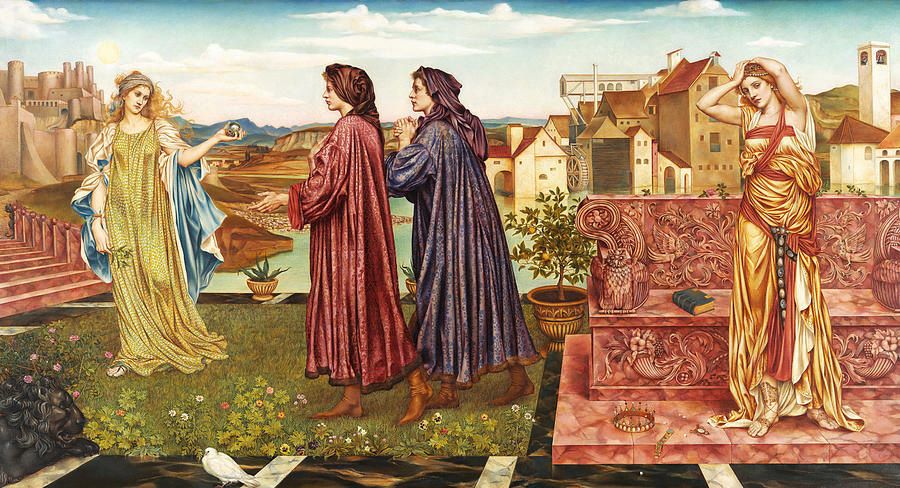
Evelyn de Morgan ‘The Garden of Opportunity’ (1892) The De Morgan Collection.
Another, The Garden of Opportunity (1892), depicts two Renaissance figures who must make a choice between two women. The one on the left is gracious and loosely gowned, while the one on the right, dressed in complicated draperies bound round with red ties, holds her head in her hands. In yet another example, Boreas and the Fallen Leaves, the bent and troubled women on the right resemble the unhappy figures in The Cadence of Autumn. Here, together with a whirl of autumn leaves, a large number of nude women move in a circle, struggling and falling as they are blown by the wind god. One lies prone on the ground; another kneels with her despairing head in her arms. All are destined to return to another life in the realm of matter.
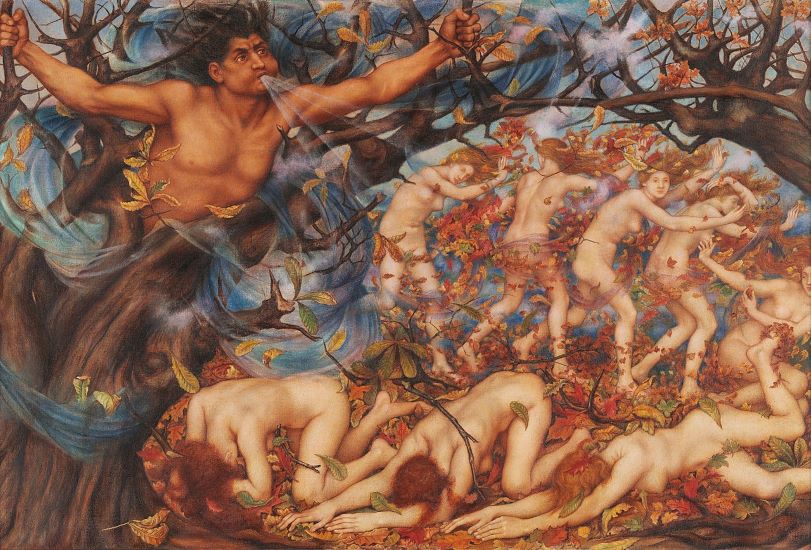
Evelyn de Morgan ‘Boreas and the Fallen Leaves’ (1910-1914). The De Morgan Collection.
Unlike Evelyn, William appears to have gone along with Swedenborg’s rejection of the idea of reincarnation. Indications of this can be seen in his letter to May Morris, quoted above. His statement that this physical life is an instalment of a larger and longer one (i.e., in the next world) gives the impression that William was not a person who thought in terms of a series of lives on earth.
The apparently differing views of the two De Morgans on this subject are hinted at in The Result of an Experiment, where, on several occasions, the spirits join in the currently popular reincarnation debate. Their viewpoint is always negative – they make comments such as ‘there is no reincarnation; the book you read is false, and the spirits who taught the doctrine were lying.’29 In another message, one says ‘India is a great land and her sages are full of wisdom but the doctrine of reincarnation is false. The man you have listened to is highly developed and his learning is great, but he lacks humility.’30
These negative attitudes might well reflect William’s point of view, but they also show that at least one member of the couple was investigating the subject. Reincarnation was a controversial concept at the time, but, as well as being integral to the world-view expressed by Thomas Taylor, the scripts (especially the second of the two quoted here) hint at contacts with the Theosophical Society, where Indian sages and reincarnation played an important part. Reincarnation was of interest to some of the members of the De Morgans’ circle, including Edward Burne-Jones.31 And no doubt Sophia De Morgan, with her wide interests, would also have discussed the subject.
CONCLUSION
Many late nineteenth century Symbolists in London, Paris and Belgium were interested in movements such as Spiritualism and Theosophy. But the majority kept their more esoteric ideas hidden, merely hinting at them, or expressing them through enigmatic symbols. A common reason, exemplified by Edward Burne-Jones, would have been a desire to appeal to a wider public which included the more conventional members of society. Though Spiritualism was popular at the time, there were many people, in the establishment and elsewhere, who viewed such beliefs as odd and eccentric. The mythology and romance depicted by Burne-Jones and others had a more general appeal than esotericism and Spiritualism.
Evelyn, in contrast, was unusually open in the subject matter of her work. She did not give lectures or write articles, but she clearly wanted to pass on her spiritual outlook to those who were ready to receive it. With this in mind, she revealed the meanings of scenes which might have been mysterious by giving them helpful titles, and using symbols which were not obscure. Did this approach make her paintings less popular? Perhaps. But her sincerity, persistence and commitment can only be admired.
Evelyn De Morgan: Notes
1 Wilhelmina’s ‘Baby’ memory is recorded in an undated notebook, located in Box 5 at the De Morgan Foundation. The notebook can be identified by its missing cover. It also contains some interesting writings, in which the young Wilhelmina (aged about twelve?) speculates on questions of reincarnation and the next world. The stories that Evelyn told her younger sister at bedtime are described in A.M.W. Stirling, William De Morgan and His Wife, London: Thornton Butterworth, 1922, pp.181ff.
2 Stirling 1922, pp.146ff.
3 Stirling 1922, p.144.
4 Stirling 1922, p.174.
5 Stirling 1922, p.386.
6 Stirling 1922, p.193.
7 Stirling 1922, pp.194f.
8 Letter from Georgie Burne-Jones to Evelyn after William’s death in 1917. Quoted in Stirling 1922, p.374.
9 Letter from William in Florence to Halsey Ricardo in London, 1900. Quoted in Hamilton, Mark,Rare Spirit A Life of William De Morgan 1839-1917, London: Constable, 1997, p.94.
10 Letter from Jane Morris to W.S. Blunt, quoted in Jane Morris to Wilfrid Scawen Blunt: the letters… /edited by Peter Faulkner, Exeter: University of Exeter, 1986, p.45.
11 De Morgan, S.E., Threescore Years and Ten, Reminiscences of the late Sophia Elizabeth De Morgan, edited by Mary A. De Morgan, London: Richard Bentley & Son, 1895, p. 95 (on Swedenborg) and pp.62ff (on Taylor). Sophia also says on p. 71 that she knew Coleridge, who had been a friend of her father’s.
12 Stirling 1922, p.312.
13 See Smith, E. L., Evelyn Pickering De Morgan and the Allegorical Body, Madison Teaneck, Fairleigh Dickinson University Press; London, Associated University Presses, 2002, p.45.
14 Letter from William De Morgan to May Morris, 3 February 1914, quoted in Stirling 1922, p.352.
15 Hamilton 1997, p.105.,
16 Stirling 1922, p.353ff.
17 Anonymous (De Morgan, E. and W.), The Result of an Experiment, London, Simpkin, Marshall, Hamilton, Kent, 1909, p.xii.
18 Result, p.54
19 Result, p.70
20 Result, p.54
21 Result, p.24
22 Result, pp.93
23 Result, p.77.
24 Poem attributed to St Augustine of Hippo – see Oberhausen, Judy, “Evelyn De Morgan and spiritualism” in Evelyn De Morgan Oil Paintings, London, De Morgan Foundation, 1996 p. 40.
25 Smith 2002, p.144.
26 Yates, P., “Evelyn De Morgan’s use of literary sources in her paintings” in Evelyn De Morgan Oil Paintings, 1996 pp.65f.
27 Cherubim are depicted as blue or gold in art, while the Seraphim are shown as red. Both have faces and four wings, but no bodies. The sources of these images are Ezekiel 1:4-21 and Isaiah 6:1-3.
28 Result, 1909, p.59.
29 Result, 1909, p.186.
30 Result, 1909, p.41.
31 See for example Harris, Lynda, British Pre-Raphaelites and the Question of Reincarnation, published in The Quest, vol 32, No. 1 – January-February 2004.
FROM – ‘A CELEBRATION OF CECIL COLLINS’ (July 2009)
This extract by JANE WISNER
Compiled and Edited by NOMI ROWE
With kind permission of the publishers – PAUL HOLBERTON PUBLISHING
This extract is from one of the contributors to the book – Jane Wisner (1944-2006). Jane attended Cecil’s classes in the early 1980s and was profoundly influenced by him. (There is a substantial selection of Jane Wisner’s work currently on this website. To view click here: JANE WISNER ART).
‘Most of Cecil’s students have dreamt about him. The first dream I ever had was simply of him and me standing in the grass which was spangled with the small flowers that appear in his painting The Sleeping Fool. We were in the realm of his pictures, the Lost Paradise, and the importance was that we were the ones who were to manifest it in this world. He was showing me how, by stepping in to it and holding a focus, a purity of consciousness, and clearing away all interference of the ego, we could make room for it. Learning how to become and then to create.
For years and years, I had been striving for peace, strength and inner harmony in my pictures, but I’d not been able to put my belief into words. I had felt so lonely, as if I was the only being on the planet trying to do things in a different way. When I met Cecil, it was as if the loneliness was over. Here was a kind, gentle, perceptive man, full of humour and mischief, erudite, expressing with ease and integrity those truths I’d believed couldn’t be expressed.. The recognition was so strong that I would be in tears every time we spoke together.
Cecil could never remember my name. To others he’d refer to me as, ‘The one who can draw’. I was extremely shy in those days and he would quietly support my self esteem. At the end of one class, he asked me to take my drawings and spread them out on the podium so everyone could see them. I had been working in a particularly intense way that day and every line was imbued with distilled energy. There was a shift in the way that he and I worked after that.
Each class was a precious gift. All boundaries were dispelled in the joy of drawing. I loved the rituals Cecil used and the times he used to talk about mythology and symbols. He would sit in a corner, his eyes lowered and as he talked the energy would build and change, shift and shimmer. It would pour into us and into the drawings. It often carried an element of great joy and was sometimes very moving. Sometimes a great peace would descend.
I sit writing this in Chichester Cathedral before the ‘Icon of Divine Light’, which Cecil painted for the altar of St Clement’s Chapel. Whenever I am in Chichester, I spend time with this wonderful image. I jump the rope and kneel as close as I can get in order to look into the eyes which gaze back into my soul. I feel the energy change. ‘Behold I make all things new.’ It is only when one goes beyond the surface of this image that it becomes active. It is only when we allow the divine to enter us that we can create on its behalf; then, if one allows oneself to become receptive and focused, one’s whole being is blessed. This is what Cecil’s teaching meant to me.’